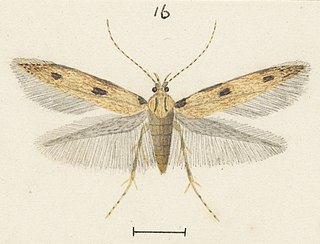
Labdia anarithma is a moth of the family Cosmopterigidae. It was described by Edward Meyrick in 1888. It is found in New Zealand and throughout Australia. Adults are on the wing from December to March and are day flying. They have been collected by sweeping bracken fern.
Labdia ancylosema is a moth in the family Cosmopterigidae. It is found in Australia, where it has been recorded from the Northern Territories.
Labdia aresta is a moth in the family Cosmopterigidae. It is found in Australia, where it has been recorded from Queensland.
Labdia argyrozona is a moth in the family Cosmopterigidae. It is found in Australia, where it has been recorded from Queensland.
Labdia arimaspia is a moth in the family Cosmopterigidae. It is found in Australia, where it has been recorded from Tasmania.
Labdia bryomima is a moth in the family Cosmopterigidae. It is found in Australia, where it has been recorded from New South Wales.
Labdia ceraunia is a moth in the family Cosmopterigidae. It is found in Australia, where it has been recorded from Queensland.
Labdia chryselectra is a moth in the family Cosmopterigidae. It is found in Australia, where it has been reported from Queensland.
Labdia ejaculata is a moth in the family Cosmopterigidae. It was described by Edward Meyrick in 1921. It is found in Australia, where it has been recorded from Queensland.
Labdia hexaspila is a moth in the family Cosmopterigidae. It was described by Alfred Jefferis Turner in 1923. It is found in Australia, where it has been recorded from New South Wales.
Labdia leucombra is a moth in the family Cosmopterigidae. It was described by Edward Meyrick in 1897. It is found in Australia, where it has been recorded from Queensland.
Labdia leuconota is a moth in the family Cosmopterigidae. It was described by Alfred Jefferis Turner in 1923. It is found in Australia, where it has been recorded from Queensland.
Labdia microchalca is a moth in the family Cosmopterigidae. It was described by Edward Meyrick in 1921. It is found in Australia, where it has been recorded in Queensland.
Labdia mitrophora is a moth in the family Cosmopterigidae. It was described by Alfred Jefferis Turner in 1923. It is found in Australia, where it has been recorded from Queensland.
Labdia niphocera is a moth in the family Cosmopterigidae. It was described by Alfred Jefferis Turner in 1923. It is found in Australia, where it has been recorded from Queensland.
Labdia niphostephes is a moth in the family Cosmopterigidae. It was described by Alfred Jefferis Turner in 1923. It is found in Australia, where it has been recorded from Queensland.
Labdia ochrostephana is a moth in the family Cosmopterigidae. It was described by Alfred Jefferis Turner in 1923. It is found in Australia, where it has been recorded from Queensland.
Labdia orthoschema is a moth in the family Cosmopterigidae. It was described by Alfred Jefferis Turner in 1923. It is found in Australia, where it has been recorded from New South Wales.
Labdia phaeocala is a moth in the family Cosmopterigidae. It is found in Australia, where it has been recorded from Queensland.
Labdia thermophila is a moth in the family Cosmopterigidae. It is found in Australia, where it has been recorded from New South Wales.
